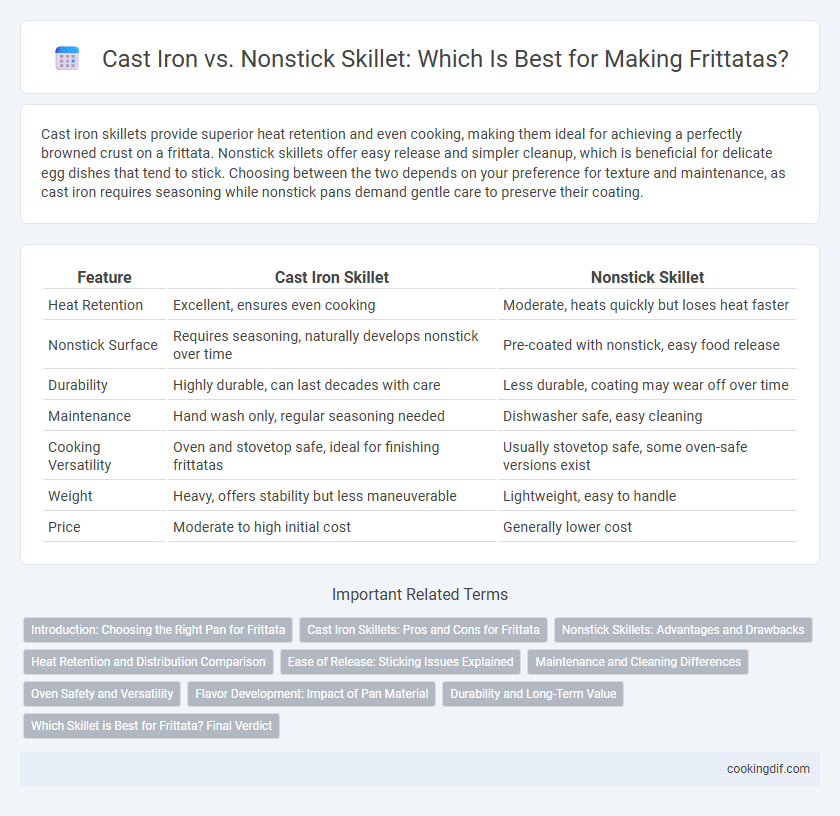Cast iron skillets provide superior heat retention and even cooking, making them ideal for achieving a perfectly browned crust on a frittata. Nonstick skillets offer easy release and simpler cleanup, which is beneficial for delicate egg dishes that tend to stick. Choosing between the two depends on your preference for texture and maintenance, as cast iron requires seasoning while nonstick pans demand gentle care to preserve their coating.
Table of Comparison
| Feature | Cast Iron Skillet | Nonstick Skillet |
|---|---|---|
| Heat Retention | Excellent, ensures even cooking | Moderate, heats quickly but loses heat faster |
| Nonstick Surface | Requires seasoning, naturally develops nonstick over time | Pre-coated with nonstick, easy food release |
| Durability | Highly durable, can last decades with care | Less durable, coating may wear off over time |
| Maintenance | Hand wash only, regular seasoning needed | Dishwasher safe, easy cleaning |
| Cooking Versatility | Oven and stovetop safe, ideal for finishing frittatas | Usually stovetop safe, some oven-safe versions exist |
| Weight | Heavy, offers stability but less maneuverable | Lightweight, easy to handle |
| Price | Moderate to high initial cost | Generally lower cost |
Introduction: Choosing the Right Pan for Frittata
Cast iron skillets offer superior heat retention and even cooking, essential for achieving the perfect frittata with a crispy, golden crust. Nonstick skillets provide easier release and simpler cleanup, ideal for delicate eggs and minimalist cooking. Selecting between cast iron and nonstick pans depends on desired texture, cooking style, and maintenance preference for optimal frittata results.
Cast Iron Skillets: Pros and Cons for Frittata
Cast iron skillets offer superior heat retention and even cooking, essential for achieving the perfect frittata texture and golden crust. Their natural nonstick seasoning improves with use, enhancing flavor development and allowing easy flipping or slicing of the frittata. However, cast iron requires careful maintenance to prevent rust and can be heavier and slower to heat compared to nonstick options, which may affect cooking convenience.
Nonstick Skillets: Advantages and Drawbacks
Nonstick skillets offer superior ease of use for cooking frittatas by preventing eggs from sticking and enabling effortless flipping and serving, which is especially beneficial for delicate mixtures. Their lightweight nature and quick heating provide efficient temperature control, but the coating can wear off over time, requiring gentle utensils and careful maintenance to avoid damage. While nonstick pans simplify cleanup and reduce the need for excessive oils, they typically lack the heat retention and durability found in cast iron alternatives.
Heat Retention and Distribution Comparison
Cast iron skillets excel in heat retention and even heat distribution, ensuring a uniformly cooked frittata with a crispy, golden crust. Nonstick skillets heat up quickly but often have uneven heat distribution, which can cause hotspots and inconsistent cooking. For optimal frittata texture and flavor, a cast iron pan provides superior temperature control throughout the cooking process.
Ease of Release: Sticking Issues Explained
A cast iron skillet provides excellent heat retention but requires proper seasoning to prevent frittatas from sticking, while a nonstick skillet offers superior ease of release with minimal oil, ensuring a seamless slide out of the pan. Cast iron may cause sticking if not preheated or maintained correctly, affecting the frittata's texture and presentation. Nonstick skillets, on the other hand, reduce the risk of tearing and ease cleanup, making them ideal for delicate egg dishes like frittatas.
Maintenance and Cleaning Differences
Cast iron skillets require seasoning to maintain their nonstick surface and prevent rust, demanding thorough drying and occasional oiling after cleaning. Nonstick skillets offer simpler maintenance with gentle hand washing and avoidance of abrasive sponges to preserve the coating. Over time, cast iron can improve in performance with proper care, while nonstick coatings may degrade and require replacement for optimal frittata cooking.
Oven Safety and Versatility
Cast iron skillets offer superior oven safety, withstanding high temperatures up to 500degF, making them ideal for frittatas that require oven finishing. Nonstick skillets typically have lower heat tolerance, often maxing out around 350degF, which limits their use in high-temperature ovens. Cast iron's durability and versatility allow seamless stovetop-to-oven transitions, whereas nonstick pans may warp or release harmful fumes if overheated in the oven.
Flavor Development: Impact of Pan Material
Cast iron skillets enhance flavor development in frittatas by providing superior heat retention and even cooking, which allows the eggs and ingredients to caramelize and develop a rich, deep taste. Nonstick pans, while convenient for easy release, often produce a softer texture and milder flavor due to less intense browning and heat distribution. The choice of pan material significantly influences the Maillard reaction during cooking, shaping the overall taste profile of a frittata.
Durability and Long-Term Value
Cast iron skillets offer exceptional durability and can last for decades, making them a valuable long-term investment for frittata preparation due to their ability to evenly retain heat and develop a natural nonstick seasoning over time. Nonstick skillets provide convenience and easy cleanup but often degrade faster, resulting in a shorter lifespan and the need for more frequent replacement. Choosing cast iron maximizes both performance and long-term value, especially for those who cook frittatas regularly.
Which Skillet is Best for Frittata? Final Verdict
Cast iron skillets provide superior heat retention and even cooking, making them ideal for frittatas that require a perfect golden crust and thorough cooking. Nonstick skillets offer easy release and minimal oil use, ideal for delicate frittatas requiring gentle handling and quick cleanup. For the best overall frittata results, cast iron is preferred for its durability and enhanced flavor development, while nonstick is suitable for convenience and simpler maintenance.
Cast iron vs Nonstick skillet for frittata pan Infographic

 cookingdif.com
cookingdif.com